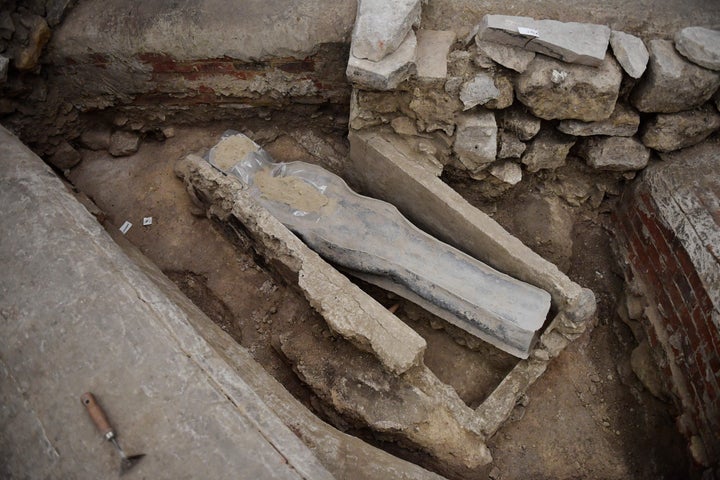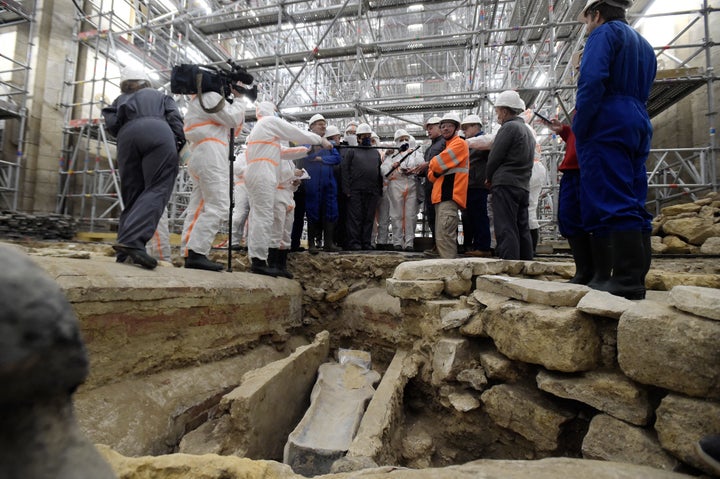Archeologists found the well-preserved lead sarcophagus beneath the famed Paris cathedral during work to repair damage from the 2019 fire.
By Ryan Grenoble
Apr. 15, 2022,
A centuries-old sarcophagus discovered beneath Paris’ Notre Dame cathedral will soon be opened, officials at France’s national archaeological institute, Inrap, said Thursday.
Archeologists discovered the well-preserved lead sarcophagus about 65 feet beneath the 850-year-old cathedral’s floor last month while doing a precautionary dig during preparations to rebuild part of the iconic French Gothic structure devastated in an April 2019 fire.
Scientists speculate the coffin could date to the 14th century, which would make the discovery extraordinary. It was found under a mound of earth that contained 14th-century furniture.
“If it turns out that it is in fact a sarcophagus from the Middle Ages, we are dealing with an extremely rare burial practice,” lead archaeologist Christophe Besnier said.

The 14th-century lead sarcophagus discovered under the floor of the Notre Dame Cathedral, in Paris, is seen on March 15, 2022.
JULIEN DE ROSA VIA GETTY IMAGES
A small camera inserted into the coffin revealed cloth and hair remains, the upper part of a skeleton, a pillow of leaves and objects that have yet to be identified.
The Inrap team also found a number of other artifacts, including a stone sculpture of a man’s head, resembling Jesus, and fragments of decorative stone, some of which still have intact paint.
“We uncovered all these riches just 10-15cm under the floor slabs,” Besnier said. “It was completely unexpected. There were exceptional pieces documenting the history of the monument.”
The discovery was “an emotional moment,” he said. “Suddenly we had several hundred pieces from small fragments to large blocks including sculpted hands, feet, faces, architectural decorations and plants. Some of the pieces were still colored.”
A small camera inserted into the coffin revealed cloth and hair remains, the upper part of a skeleton, a pillow of leaves and objects that have yet to be identified.
The Inrap team also found a number of other artifacts, including a stone sculpture of a man’s head, resembling Jesus, and fragments of decorative stone, some of which still have intact paint.
“We uncovered all these riches just 10-15cm under the floor slabs,” Besnier said. “It was completely unexpected. There were exceptional pieces documenting the history of the monument.”
The discovery was “an emotional moment,” he said. “Suddenly we had several hundred pieces from small fragments to large blocks including sculpted hands, feet, faces, architectural decorations and plants. Some of the pieces were still colored.”

France Culture Minister Roselyne Bachelot (C, left) visits the Notre Dame Cathedral archaeological research site after the discovery of a 14th-century lead sarcophagus, in Paris, on March 15, 2022.
JULIEN DE ROSA VIA GETTY IMAGES
INRAP told France24 the sarcophagus was carefully extracted from the cathedral on Tuesday and will be transported to the Institute of Forensic Medicine in Toulouse for examination “very soon.”
Institute head Dominique Garcia told the outlet the remains would be handled with the utmost respect.
“A sarcophagus containing a human body is not an archaeological object,” Garcia said. “These are human remains, and while examining the sarcophagus and analyzing the body and other objects inside, we must do so with respect.”
The remains may be re-interned at Notre Dame afterward.
It’s unclear whether the sarcophagus contains any liquid, like the “forbidden nectar” found in some Egyptian remains that hooligans have clamored to consume.
No comments:
Post a Comment